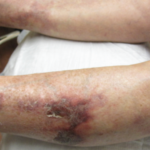WASHINGTON, D.C.—A number of new oral anticoagulants now available in the United States will eventually be used to treat autoimmune and rheumatologic diseases associated with hypercoagulability complications, such as antiphospholipid antibody syndrome or catastrophic antiphospholipid syndrome, and rheumatologists will need to begin to understand their appropriate use and potential complications, according to Craig M. Kessler, MD, professor of medicine and pathology and director of the coagulation laboratory in the department of pathology and laboratory medicine at Georgetown University’s Lombardi Comprehensive Cancer Center in Washington, D.C.
To help rheumatologists become familiar with the new anticoagulants and how to determine their appropriate use in clinical situations, Dr. Kessler presented information on a new paradigm for coagulation, as well as advantages and disadvantages of the new anticoagulants, during a session titled, “New Anticoagulants: What a Hematologist Thinks a Rheumatologist Needs to Know!” at the 2012 ACR/ARHP Annual Meeting, held November 9–14. [Editor’s Note: This session was recorded and is available via ACR Session Select at www.rheumatology.org.]
Dr. Kessler shared his experience as an expert in disorders of anticoagulation to highlight what he thinks is essential for rheumatologists to know. To illustrate the indications and risks of anticoagulation, he presented a number of case studies that show how autoimmune diseases can be treated by modulating the B cell that is involved with producing antibodies—a strategy, he said, that underlies the treatment of many rheumatologic and hematological diseases, due to similar pathological etiologies.
New Paradigm of Coagulation
Dr. Kessler laid the foundation for understanding the role for the new oral anticoagulants by describing a new paradigm of coagulation that helps explain how rheumatological diseases trigger coagulation. In the older paradigm, described as a coagulation cascade, the thought was that tissue damage to the extrinsic circulating tissue factor and clotting factor VIIA complex activates the intrinsic pathway factor IX to initiate generation of thrombin for fibrinogen cleavage and fibrin formation.
According to Dr. Kessler, in the new paradigm, described as normal hemostasis, tissue-factor bearing cells are the mainstay of coagulation in which the process of FVIIa-tissue factor complex formation occurs on the surface of tissue factor laden cells, such as monocytes and macrophages. “These cells are critical to the symptomatology and progression of autoimmune diseases and links inflammation with coagulation,” he said, adding that new treatment strategies can be developed based on this new understanding of how rheumatological diseases trigger coagulation.


